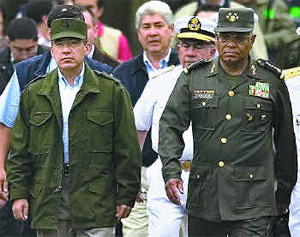 |
 |
 |
 News Around the Republic of Mexico | January 2007 News Around the Republic of Mexico | January 2007  
Mexican President Revamps Security
 Sam Logan - speroforum.com Sam Logan - speroforum.com


| | Government officials say Mexican President Felipe Calderón (left), with Defense Minister Guillermo Galván Galván, wore a military uniform to send a message of solidarity to troops. (Guillermo Arias/AP) |
In the early morning hours of 8 January, four men stepped out of a car and leveled AR-15 assault rifles at Eleazar Ruiz Vargas, the commander of public security for the Mexican state of Nuevo Leon. Supporting officers arrived on the scene only minutes later to find Ruiz’s body and a battered patrol car. Mexico’s organized criminal gangs are back to work, killing cops and each other with little regard for the loss of life or consequence.

But Mexico’s new president, Felipe Calderon, seems intent on changing that. Since his inauguration on 1 December, Calderon has unified Mexico’s anti-drug police corps under one command and transferred more than 10,000 military personnel to the federal police.

Just ten days after his inauguration, on 11 December, Calderon sent 4,260 soldiers, 1,054 marines, 1,420 federal police, 50 detectives, and numerous air force and naval support vehicles to the state of Michoacan, where violence between rival drug gangs left over 600 dead in 2006, including more than 20 decapitations.

The Michoacan capital of Morelia and the surrounding area is a battle ground for rival factions the Gulf Cartel and the Sinaloa Federation, each struggling for control of an important north-south smuggling corridor as well as the Michoacan port of Lazardo Cardernas, where authorities seized close to 20 tons of precursor chemicals used in the production of methamphetamine in early December.

Authorities organized some 131 operations to manually eradicate drug crops, and 24 checkpoints to search vehicles around the state.

Only weeks later, on 3 January, Calderon mustered another 3,000 soldiers to send north to Tijuana, considered one of the country’s principle routes for drug smuggling into the US. An additional 28 boats, 21 planes and nine helicopters accompanied the soldiers.

For decades, the once powerful Arellano Felix organization has controlled organized crime in Tijuana. In 2006, the city suffered 300 drug-related killings that many analysts associate with the struggle for the lucrative turf currently controlled by the Arellano Felix organization.

Now it appears as though the Sinaloa Federation may capture Tijuana from the Arellano Felix organization, which has been weakened over the years by a succession of arrests and the death of key leaders.

Another hot spot for criminal activity, the state of Guerrero, received the support of some 200 federal police officers on 15 January. The resort town of Acapulco, located in Guerrero, was the center of attention in 2006 as the Gulf and Sinaloa factions battled over a strategic reception point for Colombian cocaine shipped from the country’s Pacific port of Buenaventura in go fast boats and fishing vessels.

As a result, some 350 drug-related murders occurred in Guerrero in 2006, including at least 13 decapitations.

The states of Sonora, Durango and Chihuahua are also all on the list for federal security support.

Such a major thrust of federally mandated force to ensure public security instills a level of expectation that has some optimistic and others quite worried.

In his New Year’s speech, Calderon said these operations “will allow us to re-establish the minimal security conditions in different points of Mexico so we can recover little by little our streets, our parks and our schools.”

Since the beginning of the operations in Michoacan, more than 50 people have been arrested, and the government has released statistics showing a 40 percent reduction in homicides compared to the last six months.

Drug Enforcement Administration (DEA) spokesperson for Arizona, Ramona Sanchez, says increased pressure on the Mexican side of the border, such as thousands of troops sent to Tijuana, could pressure Mexican criminals to jump the border.

The governor of the state of Sonora, Eduardo Bours Castelo, agrees. He worries that increased federal presence in Baja, California, will displace criminals into Sonora, whose secretary for public security, Francisco Figueroa Bouquet, recently confirmed that the Sinaloa Federation maintains a tight grip over drug trafficking in that state.

Other leaders from around the country, including the governor of Nuevo Leon, where drug-related violence in Monterrey increased significantly in 2006, are worried that the Mexican government simply does not have the resources to maintain federal troops stretched across the whole country.

On 8 January, Nuevo Leon governor Jose Natividad Gonzalez Paras launched Operation Nuevo Leon, a state-level security operation to combat organized crime there. Since Calderon’s inauguration, the state has seen little federal assistance with Michoacan and Tijuana absorbing the bulk of federal resources.

Both state- and federal-level operations on the outset appear promising. Calderon should be commended for jump-starting Mexico’s security apparatus into action. But it is widely known that Mexico’s criminal organizations take a break from killing one another during the month of December, as pointed out last month by Aldo Fasci, an assistant to the attorney general in Nuevo Leon, so the results may not be Calderon's.

The real results of Calderon’s heavy-handed programs are yet to be seen. And if Ruiz’s death on 8 January is any indication, 2007 may prove to be another long year for Mexican public security.
Sam Logan is an investigative journalist who has reported on security, energy, politics, economics, organized crime, terrorism and black markets in Latin America since 1999. He is the Latin American correspondent for ISN Security Watch. The views and opinions expressed herein are those of the author only, not the International Relations and Security Network (ISN). | 
 | |
 |



